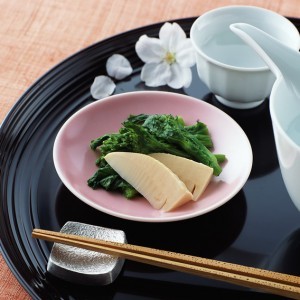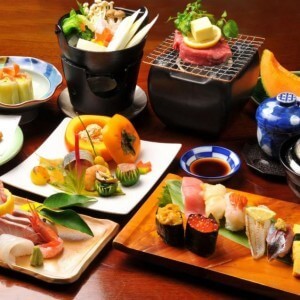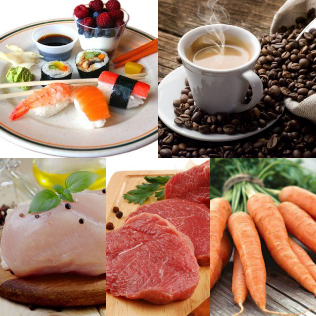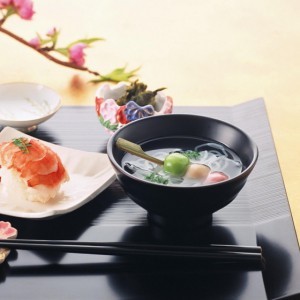
The Japanese diet is a low-carb, low-calorie diet developed by Japanese nutritionists whose protein menu allows you to lose about 10 pounds in 2 weeks.
Being overweight is now considered by many to be an incredibly fast-paced lifestyle. We are in a hurry to live, we are in a hurry to work, we are in a hurry to eat. . . Moreover, we often eat on the run and thus, as they say, God will send you. In the 21st century, God is increasingly sending us hamburgers, hot dogs, cheeseburgers, and soda. . . "What to do? Don’t waste precious minutes on lunch at a restaurant or what? ! - Do you prepare food yourself in the kitchen when the business is "on fire"? They say that the whole successful world here lives like this and nothing. "This excuse is used a lot by some people with active lifestyles. Among the styles, we choose the other, then, of course, it's time to find a new excuse. Well, in fact - of course, all this is not the result of malnutrition, but simply . . . a thick bone. Thick bone - that’s right, very insidious. And as soon as it starts to grow - everything, it is impossible to stop it.
Let us now turn our attention to Japan, a country of great potential, a high level of technological development, and an incredible pace of life. It seems that if someone does not have time to stop eating right, it is the same as the Japanese. Surprisingly, you will rarely encounter "thick bone" among Japanese residents. . . So what is the secret?
The fact is that Japanese food is a low-calorie food, rich in protein, almost no fat and "bad" carbohydrates. The main principle of the Eastern food tradition is moderation. That is why Japanese cuisine is called one of the healthiest foods for the body.
Taking into account the peculiarities of the oriental tradition of nutrition, a balanced and highly effective diet was created, which is called Japanese. In fact, this diet menu has virtually no food from traditional Japanese cuisine. But combining more fatty acids, fats and carbohydrates, in exactly the amount needed for the body to get everything it needs, will “thicken” the bone without provoking it. There are several diet options, but the most popular is the Japanese unsalted diet for 14 days. Two weeks of proper “Japanese” nutrition will help “thick bones” lose more than 10 pounds of weight and the effort will not maintain results for several years.
The essence of the Japanese diet
Those who decide to go "Japanese" should be patient and stay away from the usual way of eating for two weeks. For many, dieting may seem like a daunting task, but the effects do not last long. But amazing results will remain for several years. The "Japanese woman" only mode for two weeks - and ten kilograms (sometimes even more - it all depends on the initial weight) as it was.
What is the main secret? Why is the Japanese diet for a week better than other food systems for weight loss? In what wonderful way does it help to lose weight even if you have tried many other diets on your own, in vain?
This all applies to carefully selected products for the diet menu - they are combined to speed up the metabolic process as much as possible. Therefore, it is so important to strictly follow all instructions, eat only the specified, do not "improve" his other products, even if at first glance it seems that they are completely interchangeable. It is also not recommended to change the menu days.
The level of "hunger" is important for many women when choosing a diet, because not everyone is able to voluntarily fight the samurai against their own desires, especially the old instinct of all living things - hunger. This is why it is a fact that a two-week Japanese salt-free diet is not a "hungry" diet. To protect it you will not have to chew cabbage for a week and drink low-fat kefir, curse yourself, your excess weight and those who devised a diet. The menu of the Japanese woman contains a place of interesting and delicious recipes. This diet is especially popular with those whose breakfast usually consists only of coffee. Meat and fish lovers will not find anything difficult in it. This is the best diet for them.
The essence of the Japanese diet is easy to explain in just two words - slowing down and effectiveness.
"Japanese" is a low-calorie protein fiber diet. Carbohydrates, which are reduced to a minimum during the daily diet, force you to lose weight faster - when you need energy, the body begins to process its own fat stores into joules. But it is important to remember one more thing: the diet of a Japanese woman will not allow the body to saturate itself with the full range of vitamins and minerals. Therefore, it is strictly forbidden to diet for longer (not more than 14 days) in order not to end the weight loss course in a hospital bed.
And if you want to feel like a real Japanese, you can try Japanese sticks for Europeans instead of traditional forks and spoons. They not only convey the fabulous spirit of the country of the rising sun, but also teach how to eat and cut into small pieces. By the way, this trick is known to many proponents of the diet. Premature feeding can deceive the body and make you feel full even after very small meals. This, in fact, the Japanese should have taught the diet to lose weight.

Types of Japanese Diet
The immense popularity of the Japanese diet among women around the world has led to several variants of this weight loss system. In particular, diet options are known:
- Japanese unsalted diet for 7 days;
- for 13 days (most commonly used diet);
- for 14 days (different from the previous 13-day diet, only for one day);
- Japanese woman with green tea;
- Naomi Moriama's diet.
Proponents of each of these techniques call their favorite version a "real" Japanese woman. Moreover, many mines have already been broken in the diet copyright dispute. Some argue that it was invented by Japanese nutritionists, while others argue that the system has nothing to do with the East. Who is the author of the Japanese diet, the main thing it works. And its effectiveness has been experienced by millions of donuts around the planet.
The menu of the Japanese diet for weight loss consists of foods that contain the least calories, carbohydrates and salt, spices, sugar and sweet pastries, as well as any alcohol, so the diet is strictly considered. This promotes the rapid breakdown of fat into body fat as the body finds itself in a stressful situation and is forced to burn its own fats and calories.
Diet menu for 7 days
The 7-day Japanese diet is a lightweight variant of the traditional Japanese diet, but at the same time, the 7-day diet is the basis of the whole diet.

Predicted results: 3-5 kilograms left in the past.
Disadvantage: The duration of the result is not guaranteed, as the body has not yet had time to adapt to the new metabolic system.
Day 1
Caloric content of daily diet: 700 kcal.
Required Products:
- black coffee;
- chicken eggs;
- fresh cabbage (Beijing cabbage / white cabbage);
- tomato juice (ideally freshly squeezed);
- Lean fish.
Breakfast:
- Black coffee - it is better to give preference to espresso, but it is better to forget about sugar.
Lunch:
- boiled chicken eggs (possible 2 pieces);
- "Japanese" salad - fresh cabbage and a little vegetable oil, no need to add salt;
- a glass of tomato juice.
Dinner:
- Ideal for steamed fish - carcass, cod, pollack (part not more than 200 grams);
- Japanese salad.
Day 2
Caloric content of daily diet: 1000 kcal.
Required Products:
- coffee;
- Easter eggs;
- fish (fatty varieties);
- cabbage;
- vegetable oil;
- beef;
- Kefir.
Breakfast:
- coffee;
- Easter - Take small, weighing about 30 grams.
Lunch:
- Fish, fried or stewed - for a variety of extra fatty acids, it is best to give preference to cat fish, salmon, black halibut. In total, not more than 150 grams;
- "Japanese" salad.
Dinner:
- Beef - Boil about 200 grams. Serve without salt;
- Kefir - You can have a low-fat, but not more than 200 gram cup.
Day 3
Caloric content of daily diet: 1000 kcal.
Required Products:
- coffee;
- pumpkin / parsley;
- apple;
- chicken eggs;
- veal;
- cabbage;
- vegetable oil.
Breakfast:
- Black coffee - do not forget about the sugar moratorium.
Lunch:
- Zucchini (large enough) or parsley root (also large) - in brown vegetable oil (do not use flour or dough to burn, salt is also prohibited);
- Apples - Do not grab, it is desirable to limit yourself to one fruit.
Dinner:
- boiled chicken eggs - 2 pieces;
- Boiled veal - Limit appetite to 200 gram slices prepared without salt;
- "Japanese" salad.
Day 4
Caloric content of daily diet: 1000 kcal.
Required Products:
- coffee;
- carrots;
- cool cheese;
- chicken eggs;
- Apples.
Breakfast:
- Black non-sugary coffee.
Lunch:
- Carrots - Boil, take 3 larger roots;
- A few cheeses - choose solid varieties, limit to 20 grams;
- Raw chicken eggs - one is enough.
All the ingredients of a 4-day lunch can, if desired, be combined into one dish - a salad.
Dinner:
- Apples - Several fruits are allowed.
At this point the feeling of hunger will no longer be as strong as before. Fullness comes after small favors.
Day 5
Caloric content of daily diet: 800-1000 kcal.
Required Products:
- carrots;
- lemon juice;
- sea fish;
- juice;
- Fruits.
Breakfast:
- Carrot and lemon juice - Grate the vegetables and add the juice. You can not add sugar. Breakfast and coffee are also excluded on this day.
Lunch:
- Fried fish - get about 350-400 grams, variety - any part of the sea;
- Tomato juice - It would be better for the diet to use fresh, self-prepared. Capacity - not more than 200 grams.
Dinner:
- Fruit - but under no circumstances should you eat any variety of grapes or bananas, especially at bedtime. They will cross all the results achieved so far.
Day 6
Caloric content of daily diet: 900-1100 kcal.
Required Products:
- coffee;
- chicken fillet;
- raw cabbage;
- carrots;
- vegetable oil;
- chicken eggs.
Breakfast:
- Black non-sugary coffee.
Lunch:
- Chicken fillet - Limit portion to 500 g, get meat without skin. Boil in water without adding salt;
- Salad - On this day, it is possible to improve the traditional "Japanese" salad with the addition of grated raw carrots.
Dinner:
- Chicken eggs - Boil 2 pieces;
- Carrots (you can take large ones) - Grind raw vegetables, sprinkle the salad with a small amount of vegetable oil (possibly olive oil).
Day 7
Caloric content of daily diet: 700-800 kcal.
Required Products:
- tea;
- fruit;
- beef;
- eggs;
- cabbage;
- vegetable oil.
Breakfast:
- Tea - it is desirable to choose good varieties of green, rich in useful antioxidants.
Lunch:
- Beef - Boil a 200 gram piece. Do not use salt or other spices during cooking;
- Fruit - You can enjoy lunch dessert on the last day of the diet. But do not forget about the ban on the use of bananas and grapes.
Dinner:
For dinner on this day, as a reward for endurance, you can choose any option from the previous dinner. For example, choose a beef, egg and cabbage salad option that has olive oil as a seasoning.
For some, the diet will end. For those who have chosen long versions of the Japanese woman, the 7th day is just the equator of working on changing oneself.
For those who are accustomed to eating calories, "Japanese" may seem like a daunting task at first. But the discomfort will be noticeable only for the first few days - then the body gets used to the small portions of food, starting to eat faster. After 5 days of a new diet in the body, the first stage of restructuring begins to speed up the metabolism - the main goal of any diet is to lose excess weight, get rid of excess fluid, the swelling disappears. At the same time, you can get an anti-cellulite massage through the diet to achieve the best results.
Japanese diet for 13 days
The most popular is the 13-day Japanese diet. This version is considered to be a complete course of weight loss.
Predicted results. If you are ashamed to follow all the recipes, at the end of 13 days, you will miss about 10 kilograms and about 30 cm in volume (sometimes more).
How is it different from the 7-day version? In fact, it is a continuation of the lighter version of "Japanese Woman". That is, you will have to go through a 7-day "Japanese" life, and on the 8th day start over, repeat the days from the first to the sixth.

Japanese diet for 14 days
The basis of the 14-day version of the Japanese diet was also a 7-day menu, albeit with some nuances. The main difference from the previous two options is that in the first week you have to strictly follow the 7-day menu, and in the second week according to the same program, but in the opposite order. This means that the diet of the eighth day corresponds to the diet of the last day of the 7th day, the ninth day - the menu of the 6th day, the tenth - the menu of the 5th day. . . And according to this principle, to continue until the end of the second day, end the last 14 days of the diet with the first day of the 7-day version of the "Japanese woman".
From the 8th day of the diet, the body activates the detoxification process, and thanks to the unsalted principle of intracellular nutrition, excess fluid is removed, which completely eliminates edema. It is important that in the second week of the diet the body gets used to a new metabolic rate. Thanks to this, even after switching to a normal diet (normal - this does not mean eating in the pools for future sleep, but also you do not need to live in "starvation" mode), the body will not gain weight - fat will burn as fast as during the diet. This excellent effect will last for about 2 years. Provided the diet was properly maintained. Those who have already experienced the activity of a "Japanese woman", believe this after a year of dieting, the weight is regulated downwards. If you repeat the "Japanese woman" again (but not earlier than six months after the first course), in one year, practically, without effort, it is really possible to lose 20 kg of excess weight.
Diet and salt
Have you ever wondered why almost every more or less effective diet is taboo on salt? The thing is, according to experts,
1 gram of salt keeps a whole liter of fluid in the body.
And that's nothing more than a pound of excess weight. In addition to false excess weight, because thanks to salt, weight is accumulated not because of the fat layer, but because of fluid stagnation, excessive consumption of salt causes other problems for a person. Even a salt-free diet for a few days can lower blood cholesterol levels and improve the condition of blood vessels.
Of course, it is impossible to completely exclude salt from consumption and it is impossible to do so. But the "Japanese woman" menu contains products that already contain a certain amount of salts - enough for the normal functioning of the organs. In particular, organic salt is found in some vegetables, fish and meat. You can not eat canned vegetables, smoked meat, semi-finished products in the diet - they contain a large amount of table salt.
Green tea
In addition to the classic version of the Japanese diet, the menu also has an option that recommends using green tea instead of coffee. Many nutritionists believe that this variation of the "Japanese woman" is more beneficial to the body.
Given that the Japanese diet is based on a protein diet, it is important that green tea (in particular, its Japanese form) contains huge reserves of protein, and in terms of its nutritional value, this drink is not inferior to legumes.
The other plus in favor of green tea is the composition of antioxidants that protect the body from toxins and help eliminate toxins.
Third, and this is probably most important for those who are losing weight, the unique chemical composition of green tea helps speed up metabolism by 4 percent (60 calories burned daily than without green tea).
Japanese green tea diet lasts for 2 weeks. The components are practically the same as in the classic version of the "Japanese", although there are still excellent features.

Detailed menu of Japanese green tea diet
Day 1 / Day 14
Breakfast:
- Green tea - glass;
- low-fat cottage cheese - 150 gr.
Lunch:
- Cabbage, stewed with butter - 300 g;
- boiled chicken eggs - 2 pieces;
- Fresh apple - glass.
Dinner:
- Vegetables cooked in a salad or steamed;
- boiled or steamed fish - 200 g.
Day 2 / Day 13
Breakfast:
- Green tea - glass;
- cool cheese - 2 pieces;
- Toast or diet biscuits.
Lunch:
- Boiled or raw cabbage, seasoned with oil;
- boiled fish;
- Green tea - glass.
Dinner:
- Vegetable salad;
- boiled veal - 300 g;
- boiled chicken eggs - 2 pieces;
- Japanese green tea - glass.
Day 3 / Day 12
Breakfast:
- Japanese green tea - glass;
- Diet cookies.
Lunch:
- boiled zucchini / cauliflower;
- apples - 1 piece;
- Green tea - glass.
Dinner:
- Yellow-green vegetable salad;
- boiled veal;
- Boiled chicken eggs - 2 pieces.
Day 4 / Day 11
Breakfast:
- Japanese green tea - glass;
- low-fat cottage cheese - 150 gr.
Lunch:
- raw grated carrots with olive oil;
- chicken eggs;
- Green tea without sugar.
Dinner:
- green tea;
- Fruits (not grapes and bananas).
Day 5 / Day 10
Breakfast:
- Green tea - glass;
- Croutons with jam - 2 pieces.
Lunch:
- boiled fish - 200 g;
- Tomato juice - glass.
Dinner:
- Green vegetable salad;
- cool cheese - 2 pieces;
- Green tea - glass.
Day 6 / Day 9
Breakfast:
- rye flour crouton - 2 pieces;
- Japanese green tea - glass.
Lunch:
- raw cabbage / cooked in olive oil;
- boiled chicken without skin - 400 g;
- Japanese tea - glass.
Dinner:
- Carrots (cooked / raw);
- boiled egg - 2 pieces;
- unsweetened green tea.
Day 7 / Day 8
Breakfast:
- Japanese tea - glass;
- Cheese (any solid variety) - 2 small pieces.
Lunch:
- boiled veal - 200 g;
- cooked / steamed vegetables;
- Green tea without sugar - glass.
Dinner:
- Fruit - any;
- Japanese green tea - glass.
The effectiveness of this variant of the Japanese diet is enhanced by the addition of green tea to the diet, while the variety and flavor of the menu simplifies the period of food restriction. Repeat the diet - not earlier than one year later. So, after achieving results in two weeks, the longer you stay, in the future it is desirable to maintain a healthy lifestyle, eliminate tobacco and limit alcohol intake, and maintain proper nutrition in daily life.

Main dishes
Whichever Japanese diet you choose, any of them have a traditional cabbage salad and cooked meat. These dishes can be prepared in different ways. But keep in mind that they are part of the diet and the cooking process is slightly different from cooking. Ordinary meals.
Making the right Japanese salad:
- Get raw or slightly cooked cabbage (regular cabbage or Peking cabbage).
- by pressing finely.
- Easily drain excess moisture.
- Prepared lettuce root seasoned with olive or sesame oil.
- Stir and stop.
Diet cooked meat
- Prepare the meat. If it is chicken, remove the skin. Skin from calf or cow film.
- Rinse well with cold water.
- Put the meat in a saucepan, cover with very cold water.
- After boiling, drain the water, rinse the meat and refill with water, set on fire.
- Boil in tender condition without adding spices.
Tip: Add onions, small carrots and a little greens to the water to improve the taste during cooking. Many are wondering how to replace beef in the Japanese diet. It is allowed to include young veal in the menu, which is easier to digest, but with the same chemical composition as beef.
How were the products selected?
Almost every source says that the list of foods allowed during the Japanese diet is special and should not be changed. What is the secret of this particular diet?

Coffee. Many people start this day with this aromatic drink. One cup of black ground coffee is served as a traditional breakfast and in the Japanese diet.
What is it used for?
Black coffee without sugar, which has a revitalizing effect, helps the body to wake up faster and start the process of burning calories. And because the morning diet does not provide food, the body begins to produce energy through burning its own reserves - subcutaneous fat.
You can diversify the taste of a subversive drink by adding vanilla, dark chocolate or citrus fruits. Add additional ingredients in small doses.
Cabbage. These vegetables for the diet are not randomly selected. In addition, cabbage is one of the vegetables with the so-called "minus" caloric content (the body spends more energy on digestion than it receives).
What is it used for?
Cabbage, white or Peking cabbage strengthens blood vessel walls, lowers cholesterol levels and cleanses the intestines. For people prone to intestinal elongation, it is best to use cabbage cooking shortly before.
olive oil. A tablespoon of oil, added to lettuce, normalizes metabolism, has a beneficial effect on the liver, kidneys and pancreas.
Eggs. This product has good nutritional properties and is an excellent source of many proteins, fats and carbohydrates, as well as many vitamins and minerals.
Tomato juice. Nutritionists call it one of the healthiest. The unique chemical composition of tomatoes prevents cardiovascular and oncological diseases, accelerates metabolic processes in the body, improves mood and has a beneficial effect on the nervous system. It is best absorbed without the addition of salt, which is especially important during a salt-free diet.
Fish. Known for its ability to remove toxins and toxins quickly. It is a valuable source of proteins and amino acids. It affects the body as a prophylactic against stroke.
Fruits. Normally, during a diet, the amount of carbohydrates should be drastically reduced. But it is completely undesirable to exclude from the diet - they are an important source of energy. The body receives the "right" carbohydrates along with the fruit. But in the diet it is better to exclude bananas and grapes, which contain a lot of sugar.

Naomi Moriama Diet
It is hard not to believe the effectiveness of the Japanese diet, especially for those who nevertheless decided to try it themselves. Sooner or later, many ask the question: why is this diet called the "Japanese diet" if there is practically nothing on the menu? From the traditional dishes of the country of the rising sun. But there is an explanation for this. According to one version, this original diet is a development of nutritionists of the Japanese clinic "Yaelo".
But there is another version of the "Japanese" created by marketer Naomi Moriam - the answer to the French woman Mireille Guliano, author of the book "Why French Women Do Not Get Fat". In fact, according to research, the French are by no means the thinnest in the world. The least obese live in Japan - only 3 percent, while in France it is about 11% donuts, and in the US - more than 32%. So Naomi collected the principles of nutrition that are characteristic of her people and adapted their diet.
Rules of food from the land of the rising sun
Indigenous people eat almost 100 different foods a week, with a total caloric content of more than a quarter of, say, the weekly caloric intake of Americans. The only secret to Japanese harmony lies in the simple rule: Fill 80 percent of the stomach.














































































